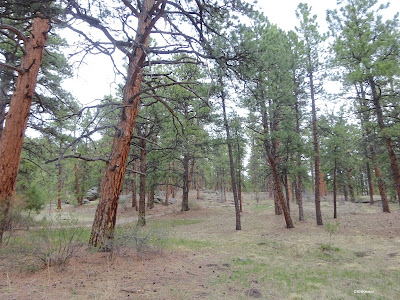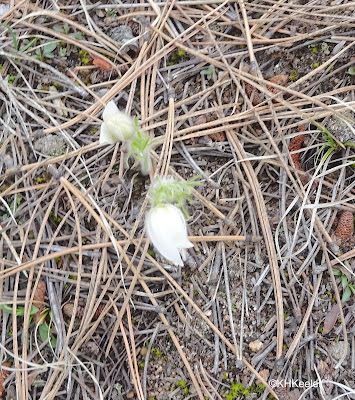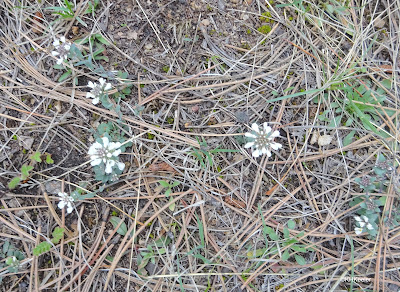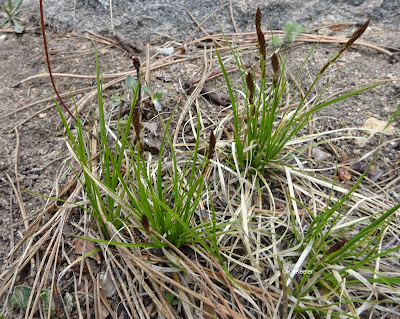It was early May at 7000' elevation. We walked out on a trail in Three Sisters Park, a Jefferson County Park, in Evergreen, Colorado. The temperature was in the 50's, the sky overcast with a prediction of rain--very pleasant, actually.
 |
| forest, Three Sisters Park, Evergreen. CO |
The trail was wide and smooth. The Park clearly is heavily used, but on a weekday morning in May, we had it almost to ourselves.
 |
| trail, Three Sisters Park, Evergreen CO |
There were leaves on the grasses, but otherwise it seemed very early spring.
Beautiful ponderosa pines (Pinus ponderosa, pine family, Pinaceae)
 |
ponderosa pine, Pinus ponderosa
|
creeping junipers (Juniperus communis var. depressa, juniper family Cupressaceae)
 |
| creeping juniper, Juniperus communis var. depressa |
and big patches of bearberry (Arctostaphylos uva-ursi, blueberry family, Ericaceae). Evergreens dominated the views.
Handsome vistas of rocks and trees
For me, it is always a plant walk, and a wildflower walk if possible.
And, yes, despite the earliness of the season, there were wildflowers.
I saw many lavender pasque flowers (Anemone patens, buttercup family, Ranunculaceae). The flowers were closed because it was cool and overcast.
 |
| pasqueflower, Anemone patens |
And one pasque flower that was definitely white.
 |
| pasqueflower, Anemone patens |
Pasqueflower is the earliest spring flower across much of northern North America. This Dakota poem welcomes and acknowledges it as leading other plants:
The Song of the Twin-Flower (the Dakota name)
I wish to encourage the children
Of other flower nations now appearing
All over the face of the earth;
So while they awake from sleeping
And come up from the heart of the earth
I am standing here old and gray-headed.
(song translated by A. McG. Beede, in Gilmore pp 80-82 link.)
Also scattered through the forest were alpine pennycress, Noccaea fendleri (formerly Thlaspi fendleri, mustard family, Brassicaceae). I'm looking down through my camera; they're about 3" tall. The Havasupai ate the seeds, the Ramah Navajo made a cold infusion to treat itches, to prevent injuries from deer, and as protection from witches.
 |
| alpine pennycress, Noccaea fendleri |
Also flowering was a sedge. I can't name it with any certainty; Colorado has 115 species of sedge (Carex, sedge family Cyperaceae), at least eight of them growing "at 7000' in pine forests in Jefferson County."
 |
| sedge, Carex |
The key in Flora of Colorado asks for the color of the rhizomes, which I didn't notice. But if the picture below, taken adjacent to the first, is the same species, then I have a dioecious species of sedge, with "male" flowers and "female" flowers on different plants...but I still don't know the species.
 |
| sedge, Carex |
Hiding at the base of a shrub--safe from grazers--were Rocky Mountain spring beauty (Claytonia rosea miner's lettuce family, Montiaceae) plants, with flowers.
 |
| Rocky Mountain spring beauty, Claytonia rosea |
The focus isn't great, but you can see what a pretty flower it is!
 |
| Rocky Mountain spring beauty, Claytonia rosea |
In another spot, they were scattered through the pine needles like stars.
 |
| Rocky Mountain spring beauty, Claytonia rosea |
Claytonia is a genus with species all across North America, and tribes from the Atlantic to the Pacific told ethnobotanists they ate spring beauty leaves, fresh or cooked, though I can't find a specific mention of this species.
Don't go gathering wildflowers in parks or natural areas; get permission of the land owner before taking anything and be sure to take no more than 1/3 of the plants you see. I include the information because, walking Rocky Mountain paths in early spring, I was walking in the footsteps of generation upon generation of Native Americans and it was good to draw on their lore for the plants I saw.
Spring is coming to the mountains, slowly moving up in elevation.
It was a lovely and solitary hike.
Comments and corrections welcome
References
Ackerfield, J. 2015. Flora of Colorado. BRIT Press. Fort Worth, TX.
Gilmore, M. R. 1919. Uses of Plants by the Indians of the Missouri River Region. Government Printing Office. Washington, D.C. link (Accessed 5/7/23).
Keeler, K.H. this blog Creeping juniper, prostrate juniper, Juniperus communis var. depressa link
Keeler, K. H. this blog. Pasqueflower Anemone patens, aka Pulsatilla patens link
Moerman, D. E. 1998. Native American Ethnobotany. Timber Press. Portland, OR. Online: link
Kathy Keeler, A Wandering Botanist














No comments:
Post a Comment